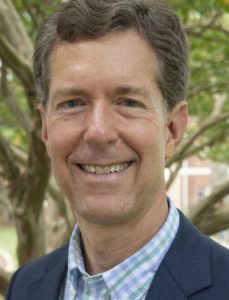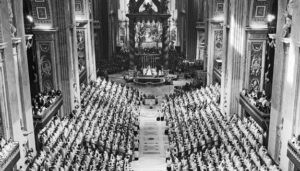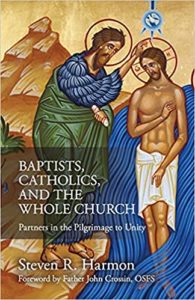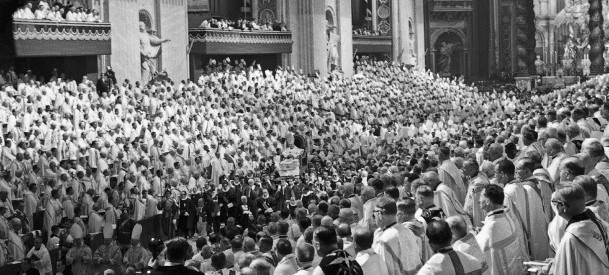A few years ago, I delivered a keynote address for a symposium on the Vatican II Decree on Ecumenism, Unitatis Redintegratio, held at Creighton University in connection with the 50th anniversary of its promulgation on Nov. 21, 1964. The fact that I as an ordained Baptist minister and professor of theology in a Baptist-related school of divinity was invited to deliver this address at a Jesuit-related university is one small piece of concrete evidence that the Vatican II Decree on Ecumenism accomplished something in the life of the one, holy, catholic and apostolic church. It left a lasting legacy both in the Catholic Church and in the Baptist tradition, for which anti-Catholicism had great historical influence in shaping its identity. But a half-century ago, things didn’t look very promising for Baptist and Catholic progress together toward more visible expressions of Christian unity.

Steven Harmon
Back in 1964, the promulgation of Unitatis Redintegratio was an event experienced by Baptists incompletely and indirectly at best. Baptist Press staff writer W. Barry Garrett, an accredited journalist for the second through fourth sessions of the Council, wrote this in his wrap-up reflections on the adjournment of the third session published on Nov. 25, 1964, by the news service of the Southern Baptist Convention:
After 12 weeks of direct reporting on the council in action at the second and third sessions, this reporter finds it difficult to understand all he knows about what is going on. For those who have not been present it should be even harder to arrive at final conclusions of either approval or disapproval of what is happening.
The difficulty many Baptists have had appreciating Vatican II in general and the Decree on Ecumenism in particular is not unlike Thomas the Apostle’s difficulty with Jesus’ resurrection — both difficulties are attributable not so much to a lack of perception as a lack of presence. Thomas was absent from the earliest post-resurrection appearances of Jesus to the gathered disciples, as were Baptists from the “Brotherhood of St. Longinus,” the nickname adopted by the group of observers officially delegated by Christian world communions, who experienced the Council from the tribunal of St. Longinus in St. Peter’s Basilica as well as through personal interactions with the bishops and their theological assistants during their time in Rome.
On April 3, 1962, then-Monsignor Johannes Willebrands of the Secretariat for Promoting Christian Unity met in Geneva with the heads of the Christian world communions, including Josef Nordenhaug, general secretary of the Baptist World Alliance. Monsignor Willebrands communicated plans that delegated observers be included in the Council and asked the general secretaries to explore with their organizations the possibility of sending official observers. On April 25, General Secretary Nordenhaug received a letter from Monsignor Willebrands asking whether the BWA would send an observer if formally invited. Nordenhaug referred the letter to the BWA Executive Committee, which devoted a whole day of its meeting in Oslo, Norway, on Aug. 22, 1962, to debate on the matter. The Executive Committee finally decided, “It is not agreed it would be desirable for the Baptist World Alliance to encourage a formal invitation to the forthcoming Second Vatican Council,” and voted to exclude the record of the day’s debate from the minutes.
The (BWA) Executive Committee finally decided, “It is not agreed it would be desirable for the Baptist World Alliance to encourage a formal invitation to the forthcoming Second Vatican Council,” and voted to exclude the record of the day’s debate from the minutes.
It is commonly understood that opposition from the SBC, the largest Baptist union and most significant financial contributor to the BWA, was a major factor in this decision, along with opposition from Latin American Baptist unions that had their origins in Southern Baptist missionary work and whose ecclesial identities were largely formed in contrast to the Catholic majority in their context. While anti-Catholicism was involved, opposition to this particular ecumenical opportunity was also part of a larger pattern of resistance to the modern ecumenical movement within part of the global Baptist community.
Thus, the BWA became the only Christian world communion not to send observers, and the global Baptist community lost the opportunity to understand what was happening more fully and even to shape what was happening. According to Catholic theologian Yves Congar, one of the most significant theological influences on Vatican II, “The presence of … observers from the non-Roman Catholic Christian Communions (was) one of the most import elements in the conciliar situation.”

Pope John XXIII leads the opening session of the Second Vatican Council in St. Peter’s Basilica Oct. 11, 1962. The council’s four sessions and its 16 landmark documents modernized the liturgy, renewed the priesthood and religious life, enhanced the role of lay Catholics, opened dialogue with other churches and non-Christians, and identified the church as the “people of God” attuned to the problems and hopes of the world. (CNS photo/L’Osservatore Romano)
Anglican bishop John Moorman recalled that Monsignor Willebrands told him: “The presence of observers here is very important. You have no idea how much they are influencing the Council.” A 2014 journal article by Donald Norwood on “The Impact of Non-Roman Catholic Observers at Vatican II” concluded that they “helped the council evolve from what could have been a purely domestic affair and a rubber-stamping exercise … into a genuinely ecumenical, deliberative, debating and decision-making council of the worldwide Church” and that “on many disputed questions, the presence (of) and conversations with observers tipped the balance, (for example) in the case of what to say and not say about Mary or religious freedom.”
The observers in turn played key roles in the post-conciliar reception of the Council by their own communions and beyond. Baptists missed out on the opportunity to have both kinds of influence on what happened at the Council and on what happened in its aftermath.
Nevertheless, beyond W. Barry Garrett’s journalistic representation, there was a Baptist presence among the guests of the Secretariat for Promoting Christian Unity. These included J.H. Jackson, president of the historically black National Baptist Convention, USA; Stanley I. Stuber, a minister from the American Baptist Churches USA who was then serving as executive director of the Missouri Council of Churches; W. Morgan Patterson, professor of church history at Southern Baptist Theological Seminary in Louisville, Ky.; James Leo Garrett Jr., professor of theology at Southern Baptist Theological Seminary, who was present for the promulgation of the Declaration on Religious Liberty in the fourth session (and who was later my own professor at Southwestern Baptist Theological Seminary in Fort Worth, Texas).
Baptist reception of Vatican II was dependent largely on second-hand reports and third-hand interpretations of the Council’s actions.
Another Baptist guest was Claude Broach, then pastor of St. John’s Baptist Church in Charlotte, N.C. Broach was dismayed that Baptists had declined to send an observer, and as an act of grassroots ecumenical engagement he was able to secure an invitation from a local bishop to visit the final session of the council as his personal guest. But none of these Baptist guests had the status and vantage point of the delegated observers, and consequently Baptist reception of Vatican II was dependent largely on second-hand reports and third-hand interpretations of the Council’s actions.
In spite of this shaky start, ecumenical relationships between Baptists and the Catholic Church have made great strides since the non-participation of Baptists in the “Brotherhood of St. Longinus.”
My new book, Baptists, Catholics, and the Whole Church: Partners in the Pilgrimage to Unity, is about the remarkable subsequent progress Baptists and Catholics have made in their relationships with one another. It’s also about the possibility that Baptists and Catholics might be able to walk further together as fellow pilgrims, along with others in the whole church, on the path that leads to fulfillment of Jesus’ prayer for his followers “that they may all be one … so that the world may believe” (John 17: 21).
 Steven R. Harmon is professor of historical theology at Gardner-Webb University School of Divinity in Boiling Springs, N.C. This column is excerpted from his new book Baptists, Catholics, and the Whole Church: Partners in the Pilgrimage to Unity, with the permission of the publisher, New City Press. The book will be released later this month but is available for advance purchase.
Steven R. Harmon is professor of historical theology at Gardner-Webb University School of Divinity in Boiling Springs, N.C. This column is excerpted from his new book Baptists, Catholics, and the Whole Church: Partners in the Pilgrimage to Unity, with the permission of the publisher, New City Press. The book will be released later this month but is available for advance purchase.
BNG readers are especially invited to participate in a book launch webinar on Wednesday, Sept. 22., at 1 p.m. Eastern time, featuring a conversation between Steven Harmon and Paul Murray, professor of systematic theology and dean and director of the Centre for Catholic Studies at Durham University (UK). Register for the webinar here.
Related articles:
Longing for tradition: The example of Pope Francis and the Latin Mass and what it means for non-Catholics | Analysis by Derek Hatch
Baptist-Catholic dialogue resumes despite challenges of pandemic
SBC leader: Baptists, don’t let your babies grow up to be Catholics

